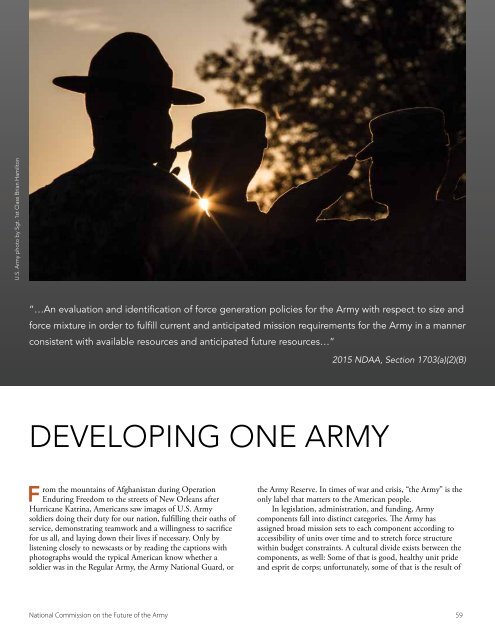THE FUTURE OF THE ARMY
Futurearmy
Futurearmy
You also want an ePaper? Increase the reach of your titles
YUMPU automatically turns print PDFs into web optimized ePapers that Google loves.
U.S. Army photo by Sgt. 1st Class Brian Hamilton<br />
“…An evaluation and identification of force generation policies for the Army with respect to size and<br />
force mixture in order to fulfill current and anticipated mission requirements for the Army in a manner<br />
consistent with available resources and anticipated future resources…”<br />
2015 NDAA, Section 1703(a)(2)(B)<br />
DEVELOPING ONE <strong>ARMY</strong><br />
From the mountains of Afghanistan during Operation<br />
Enduring Freedom to the streets of New Orleans after<br />
Hurricane Katrina, Americans saw images of U.S. Army<br />
soldiers doing their duty for our nation, fulfilling their oaths of<br />
service, demonstrating teamwork and a willingness to sacrifice<br />
for us all, and laying down their lives if necessary. Only by<br />
listening closely to newscasts or by reading the captions with<br />
photographs would the typical American know whether a<br />
soldier was in the Regular Army, the Army National Guard, or<br />
the Army Reserve. In times of war and crisis, “the Army” is the<br />
only label that matters to the American people.<br />
In legislation, administration, and funding, Army<br />
components fall into distinct categories. The Army has<br />
assigned broad mission sets to each component according to<br />
accessibility of units over time and to stretch force structure<br />
within budget constraints. A cultural divide exists between the<br />
components, as well: Some of that is good, healthy unit pride<br />
and esprit de corps; unfortunately, some of that is the result of<br />
National Commission on the Future of the Army 59


